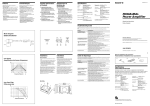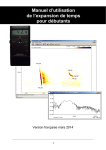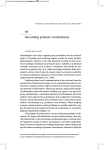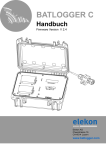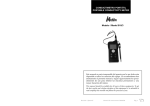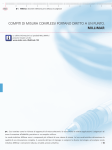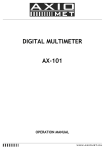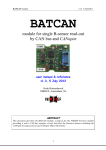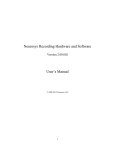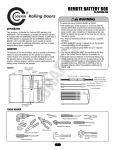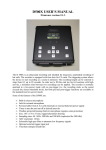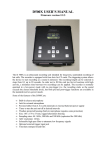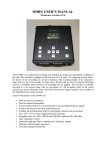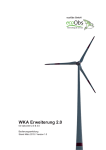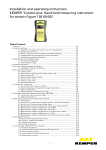Download Bat Detector Information Pack
Transcript
Bat Detector Information Pack The Basics There are four types of bat detector: 1. Heterodyne Heterodyne detectors are tuneable – you select the frequency range to listen to. This makes them the best detectors for immediate identification of bats in the field. They work by filtering the inaudible bat sound with an ultrasonic signal from the detector, and producing the audible difference between the two sounds. Sounds can be recorded onto a recorder, but recordings cannot be used with sound analysis software to generate sonograms as frequency information is not retained. They are the cheapest of the detectors and are simple to use, making them ideal for beginners. 2. Frequency Division Frequency division detectors detect all frequencies, so there is no need to tune in to a specific frequency and you don’t miss any bats. They work by outputting a single sound wave for every ten waves (if divided by 10) in the original call, thereby making the calls audible by reducing the frequencies by a factor of ten, while still enabling you to hear the calls in real-time. Sounds can be recorded and analysed with sound analysis software but some information is lost. They are generally low to mid-price, but cheaper versions tend not to retain amplitude information. 3. Time Expansion Like frequency division detectors, time expansion detectors detect all frequencies. They work by digitally recording a short snatch of sound (e.g. 1 second), then playing it back at a slower speed, resulting in very high quality recordings and retention of the same information as the original call. However, recording is not continuous as calls are not detected during the playback period, so snapshots of calls are sampled. Sounds can be recorded and used with sound analysis software. They enable a very detailed analysis of the sound and a clearer sonogram when compared to frequency division. They are among the most expensive of the detectors. 4. Full Spectrum, Real-time Sampling Like frequency division and time expansion detectors, full spectrum, real-time sampling detectors detect all frequencies. They sample at very high rates to capture all signal information and output it in real-time – so you get the detail of call structure as with time expansion, but also the real-time continuous monitoring as with frequency division. Sounds can be recorded and used with sound analysis software. They enable a very detailed analysis of the sound and a clearer sonogram when compared to frequency division. They are generally more expensive than frequency division and time expansion detectors. Additional note Some detectors feature more than one type of sound conversion. For example, some frequency division detectors have a heterodyne mode as well, and some feature three models of sound conversion. There are a number of factors to consider when choosing a bat detector. These include: Price Microphone and frequency range: Microphones determine the sensitivity of the bat detector. Piezo – best at mid frequencies (~45kHz), MEMS – mid frequencies (40-60kHz), Electret – lower frequencies (<30kHz), and Capacitance – higher frequencies (>80kHz). You will still be able to detect other frequencies, but the distance from which you can detect them will vary. Detectors with more than one microphone are best, because they will be sensitive at more than one frequency (e.g. Pettersson D100 overleaf). All European species are detectable within the range 20-120kHz. Bandwidth: How many kHz either side of your tuned frequency on which you can hear calls (heterodyne). A wider bandwidth reduces the chances of missing species you are not tuned into, while a narrower bandwidth makes it easier to discern the difference between bats calling at similar frequencies. Design: size, display (LED/LCD), controls on side or top (side-controls easier for single-handed operation). The following is a guide to some of the detectors that are available on the market at the present time and their main features. It is not intended as a review and prices should only be used as a guide as they may change over time or between suppliers. BCT do not recommend any specific type or model of detector. Heterodyne Bat Detectors (Summary, in price order) Model Approx cost £40 Microphone (type & no.) unknown Frequency range unknown Bandwidth Batteries Size (mm) Speaker 16kHz (± 8kHz) 1 x 9V (PP3) 145x80x34 Y Semafor UF-140 £46 unknown 10-140kHz unknown 1 x 9V (PP3) 145x60x45 Y Semafor UF-220 £55 unknown 10-220kHz unknown 1 x 9V (PP3) 145x60x45 Y Ciel CDB 105 R2 Mono £60 Electret (1) 18-120kHz 10kHz (± 5kHz) 1 x 9V (PP3) 140x64x31 Y Magenta Bat4 £62 Electret (1) 15-130kHz 9kHz (± 4kHz) 4 x AAA 145x80x34 Y Ciel CDB 103 R3 Stereo Magenta Bat5 £90 Electret (2) 15-130kHz 10kHz (± 5kHz) 1 x 9V (PP3) 170x75x40 Y £95 Electret (1) 10-130kHz 9kHz (± 4kHz) 4 x AAA 135x72x27 Y Ciel CDB 101 R3 Stereo £120 Electret (2) 15-130kHz 10kHz (± 5kHz) 1 x 9V (PP3) 170x75x40 N Ciel CDP 102 R3 Professional Stereo £150 Electret (2) - external 15-130kHz 13kHz (± 6.5kHz) External 9-12V DC Source 125x75x40 N Boxed (for mounting and long-term surveys). Stereo/dual option-can observe 2 frequencies at same time. LCD display. Mini-3 £155 Electret (1) 15-160kHz 8kHz (± 4kHz) 2 x AA 147x65x40 Y Large illuminated tuning dial. Batbox IIID £156165 Electret (1) 19-125kHz 16kHz (± 8kHz) 1 x 9V (PP3) 125x69x32 Y Digital LCD display with backlight. Side controls. Wrist strap. Magenta MkII Kit Design features/ other factors Requires soldering & electronics skills & the ability to understand circuit diagrams. Integrated LED torch. ( ‘BATZ’ model also available-same spec. aimed at children) LED torch. Large frequency dial with top illumination. Side controls for singlehanded operation. Wrist strap. LED display. Wrist strap. LCD display with backlighting. Inbuilt LED torch. Side controls for single-handed operation. Wrist strap. LCD display. External speaker can be added. Wrist strap. Model Approx cost £170 Microphone (type & no.) Electret (2) Frequency range 15-130kHz Bandwidth Batteries Size (mm) Speaker 10kHz (±5kHz) 1 x 9V unknown N Batscanner £187 Electret (1) 15-120kHz unknown 3 x AAA 120x65x27 Y SSF Bat2 £215 MEMS(1) 15-130kHz 10kHz (±5kHz) 4 x AA 185x65x28 Y Pettersson D100 Pettersson D200 £220 Electret (1) & Piezo (1) Electret (1) 10-120kHz 8kHz (± 4kHz) 8kHz (± 4kHz) 1 x 9V (PP3) 1 x 9V (PP3) 113x71x33 Y 119x60x25 Y Ciel BM1 Professional Stereo £280 10-120kHz Design features/ other factors Clock, temp & humidity sensor. Bat counter. Can categorise frequency into 3 different ranges for counting different spp. Wrist strap. Adjusts automatically to detected frequency. LED display. In addition to heterodyne function, also uses frequency division to monitor all frequencies & reports peak frequency. Backlit frequency control. Fully backlit LCD display. Side controls – easy to adjust. Broadband Bat Detectors Frequency Division Detectors (Summary, in price order) Model Approx cost Division Factor Microphone Freq. range Amplitude retaining Batteries Size (mm) Design features/ other factors 1 x 9V (PP3) 1 x 9V (PP3) 140x64x31 LED torch. 165x46x34 4 x AA (internal) or 12V (external) 155x90x45 Comes with BatScan sound analysis software. Very simple design & easy singlehanded operation. Designed for unattended long-term monitoring. CF & GPS compatible. PDA with pre-loaded software. Does not retain amplitude so analysis based largely on call structure and frequency parameters. FREQUENCY DIVISION ONLY Ciel CDB 205 Mono Batbox Baton £60 10 Electret (1) 18-120kHz N £80 10 Electret (1) 20-120kHz Y Anabat SD2 and PDA package £2,090 8,16,32 Capacitance (1) 4-200kHz N/A FREQUENCY DIVISION AND HETERODYNE Ciel CDB 305 R2 Dual £100 10 Electret (1) Ciel CDB 301 R3 Advanced £200 10 Electret (2) Batbox Duet £255280 10 Electret (1) 18-120kHz Bandwidth: 10kHz (± 5kHz) 15-120kHz Bandwidth: 10kHz (± 5kHz) N 1 x 9V (PP3) 140x65x40 Wrist strap. Y 1 x 9V (PP3) 170x75x35 17-125kHz Bandwidth: 16kHz (± 8kHz) Y 1 x 9V (PP3) 125x69x32 Backlit LCD display. Separate microphones for each function. Commentary button enabling note-taking. Wrist strap. Large LED display & control for singlehanded operation. Wrist strap. Model Approx cost Division Factor Microphone Freq. range Amplitude retaining Batteries Size (mm) Design features/ other factors Pettersson D230 £450 10 Electret (1) 10-120kHz Bandwidth: 8kHz (± 4kHz) Y 1 x 9V (PP3) 119x60x25 LCD Display. Comment switch. Wrist strap. U30 £630 10,20,40 unknown 15-200kHz Y 2 x AA 147x65x40 Miniature ‘ultra-lownoise’ microphone. Dodoultra* unknown 10 unknown 10-125kHz unknown 2 x AA 147x89x25 Het/frequency shift. In f.s. mode, is a broadband detector & displays peak. F.s. output can be recorded through headphone socket. LCD Display. *NB this detector uses frequency shift instead of frequency division. The signal is digitally processed to reduce the frequencies by ten with less loss of information. Time Expansion Detectors (Summary, in price order) Model Approx cost Expansion Factor Microphone Freq. range Batteries Size (mm) Design features/ other factors 145x95x45 Hands-free (worn around neck). No speaker. 4 x AA (& internal battery) 1 x 9V (PP3) 155x95x52 LED display. Internal digital recorder. 10.24sec memory. 119x60x25 4 x AA 170x110x40 LCD Display. Comment switch. Storage time 3.4, 1.7 or 0.1sec. Automatic or manual trigger. 25.6sec memory. Voice commentary. Time tag-30min intervals. Back-to-back recording. TIME EXPANSION ONLY Tranquility Transect £470 N/A Capacitive 10-160kHz 4 x AA TIME EXPANSION AND HETERODYNE Tranquility III £755 10,32,64 Capacitive 12-160kHz Pettersson D240x £1160 10 Advanced Electret (1) 10-120kHz 8kHz (± 4kHz) ECO-Mega £1555 10,32,64 Capacitor 12-160kHz Time Expansion, Frequency Division, Heterodyne and Full Spectrum Sampling Model Approx cost Frequency/ Expansion Factor Microphone Freq. range Batteries Size (mm) Design features/ other factors Batbox Griffin £15001550 8,10,16 (FD) 16 (TE) Electret unknown AA unknown Pettersson D1000x £4350 From 1 (original speed) to 30 Capacitance (1) 10-200kHz Internal batteries or external power supply 6-10V 170x80x35 Built in recording. Date, time, temp & light reading levels. Programmable menu-driven function set-up. Can record continuously (up to a max file length of one hour) for full spectrum, real-time sampling. Built-in recording. 16-bit recording system using compact flashcard as storage. Manual or level-triggering modes. Comments recording mode. TE factor of 1 (for real-time full spectrum sampling) to 30 can be selected. (built to order) Full Spectrum, Real-time Bat Recorders (long-term, unattended monitoring) Model Approx cost Microphone Freq. range Batteries Size (mm) Design features/ other factors (Email [email protected] for quote) Electret (1) 16-150kHz) 4 x AA unknown Song Meter SM2 Ultrasonic 384 kHz Digital Field Recorder £995 SMX-US Up to 190kHz 4xD unknown Analyses microphone signal in realtime & discriminates between bat calls & other sound signals. Autonomous long-term monitoring. Independent recording device & software built to co-operate with the hardware. Designed for long-term deployment. Records frequencies up to 192kHz. Sufficient for monitoring nearly all spp. present in Europe. Second channel can be used with conventional SMX-II microphone to record other wildlife at scheduled times, though not simultaneously with ultrasonic monitoring. Song Meter SM2 Ultrasonic 192kHz Digital Field Recorder £995 SMX-US Up to 190kHz 4xD unknown Designed for long-term deployment. Records frequencies up to 96kHz. Widely used in North America. Two channels double monitoring potential & can record simultaneously. Batlogger £1535 Electret (1) 10-150kHz 155x80x38 Manual or automatic recording. Integrated GPS. Coordinates & temperature recorded with each sound recording. Free BatExplorer analysis software. Pettersson D500x £1795 Electret (1) N/A Sampling rates: 44.1, 300, and 500kHz (optim. for 500kHz) 3.7V 4600mAh Li-Ion 12 V DC charger 4 x AA or external power supply 184x172x52 Detects & records ultrasound in real-time. Aimed for long-term unattended recording of bat calls. 4 slots for CompactFlash memory cards with total capacity of 128GB. Triggering system allowing device to start recording as sound is detected. Batcorder Manufacturers and suppliers (details correct at time of going to print) Alana Ecology Ltd: www.alanaecology.com The Old Primary School, Church Street, Bishop's Castle, Shropshire, SY9 5AE Tel: +44 (0)1588 630173 Email: [email protected]. Anabat SD1 Batbox: III-D, Baton, Duet, Griffin Magenta: MKII Kit, Bat4, Bat5 Mini-3 Pettersson D100, D200, D230, D240x, D500x, D1000x Batbox Ltd: www.batbox.com 2A Chanctonfold, Horsham Road, Steyning, West Sussex, BN44 3AA Tel: 01903:816298 Email: [email protected] Batbox III-D, Baton, Duet Bat Management: www.batmanagement.com US-based – email for a UK quote [email protected] Pettersson D200, D500x (only available here), D1000x Bat Planet: www.batplanet.co.uk C/o Yarwood Ltd, Treefield Industrial Estate, Gelderd Road, Leeds LS27 7JU Email: [email protected] Full range of Ciel detectors (not including CDP 302), Belfry bat detector Bioquip: www.bioquip.net Batbox III-D and Duet Full range of Ciel detectors (not including CDP 302) Courtpan: http://courtpan.gnxt.net 3 Suffolk Street, Cheltenham, GL50 2DH Tel: 01242 570123 Email: [email protected] Tranquillity Transect, Tranquility III, ECO-Mega Dodotronic: www.dodotronic.com Via de Gasperi 5, 00040, Castel Gandolfo, RM, Italy Email: [email protected] Dodoultra EcoObs: www.ecoobs.com Contact via online contact form http://www.ecoobs.com/cnt-contact.html Batcorder Elekon AG: http://www.elekon.ch/en/batlogger/products/ Cheerstrasse 16, CH-6014, Lucerne, Switzerland Tel: +41 41 250 40 40 Email: [email protected] Batlogger, Batscanner Green witch: www.green-witch.com (search for bat detectors) Tel: 01954 211 288. Batbox: III-D, Baton, Duet, Griffin (available to pre-order) Magenta Electronics Ltd: www.magenta2000.co.uk 135 Hunter Street, Burton on Trent, Staffs, DE14 2ST Tel: 01283 565435 Email: [email protected] Magenta: MKII Kit, Bat4, Bat5 NHBS: http://www.nhbs.com/ 2-3 Wills Road, Totnes, Devon, TQ9 5XN Tel: 01803 865913 Email: [email protected]. A range of detectors including SSF Bat2 Pettersson Elektronik AB: www.batsound.com Sweden-based – email for a UK quote [email protected] Full range of Pettersson detectors (except D500x) Semafor: http://www.semafor.co.uk/bat-detector.html Email: [email protected] (for a catalogue) Semafor UF-140, UF-220 Titley Electronics: www.titley.com.au Australia-based – can be shipped to UK. Email: [email protected] Anabat SD1 and SD2 Ultra Sound Advice: http://www.ultrasoundadvice.co.uk 27 Merton Hall Road, Wimbledon, London SW19 3PR Tel: 020 8287 4614 Email: [email protected] Mini3 Detector, U30 Detector Sound Analysis Software A selection of software packages for analysing bat echolocation calls recorded using a broadband bat detector (time expansion or frequency division) are listed here (with some of the more frequently used ones at the start). We do not recommend specific packages, but BCT training courses in sound analysis cover the following: BatSound, BatScan, Wavesurfer, and TF32. Adobe Audition v 3.0. is a substantial package that calculates all the start/end/peak frequencies of a pulse for you and allows you manipulation sounds. It can also convert batches of mp3 or other formats to WAV format quickly. You can also listen to heterodyne separate from the FD channel on Duet recordings. Audition v 3.0 is available as a 30 day try-out and the full package is $350. Web site http://www.adobe.com/uk/products/audition/ Avisoft at www.avisoft.com offers a free download of a minimal program called SAS Lab Lite (5.7 MB) for very basic editing and generation of spectrograms. The full Avisoft has a whole range of functions although it takes time to learn how to use them all. Bat Scan, available from www.batbox.com,comes with a selection of sample files so that you can compare your own recordings. It costs £17 (plus VAT and delivery) and is a simplified version of Spectrogram. In general it is faster and easier to use than BatSound, but does not have all of the functions. It is designed to be used with frequency division recordings. Follow-up service and advice is good. It is also available from Alana Ecology www.alanaecology.com at £30 (including VAT). BatSound is the original software developed by Pettersson especially for use with ultrasonic bat calls and is generally considered to be the industry standard. It is available directly from Pettersson (http://www.batsound.com/?p=34), and also from Alana Ecology (www.alanaecology.com). Costs start at around £275 for a single user licence, and more for multiple licences. BatSound has a nice big window for sonograms and an easy to use toolbar with shortcut buttons that operate on a mouse click for common functions. It also has lot of additional functions and newer versions have improved settings. The help files are generally well-structured and easy to use. Newer versions also allow you to import mp3 files directly into BatSound and to manage recordings from the D500x. You can download an evaluation version of the latest software for free from the Pettersson website. TF32 is a free programme designed for speech analysis. A user manual is available from http://www.medsch.wisc.edu/~milenkvc/tools.html and a sound analysis instruction booklet from BCT. Wavesurfer is another completely free program available from http://www.speech.kth.se/wavesurfer. This was developed for speech analysis and you need to establish your own spectrogram parameters and save them. Therefore, you need to know a little about the terminology (FFTs, etc.) or you can look at the ibats website for instructions written by Dr Jon Russ (http://www.ibats.org.uk/page.aspx?tabid=256. Cool Edit Pro 2.1, produced by Syntrillium, has been taken over and is now sold as Adobe Audition. However, the old version is available as a free download from http://www.softpedia.com/progDownload/Cool-Edit-Pro-Download-2076.html (18.20MB) for a 21-day free trial in which you can analyse 10ms calls. The spectrogram and oscillogram cannot be viewed simultaneously. There are also a number of programs that have been developed in the USA and/or are designed to work with Apple Macs, although most of these have not been tested. Sonobat v 2.5.5 is a program developed in the USA. It includes an auto-trigger recording function developed especially for the D240x set up to trigger automatically and allowing remote recording to a digital recorder. It allows you to look at reference calls in the same window next to a call that you are trying to identify. Reference calls are automatically adjusted to match the time and frequency scale of the one you are looking at. Analysis functions are plentiful including definition of low/high frequencies, bandwidth, duration, heel, slope, characteristic frequencies, harmonics and automatic calculation of the inter-pulse interval. The program costs US$320. There is a free downloadable demo of v2.4 for Mac and PC (http://www.sonobat.com). bcAnalyze 1.0 is a programme designed to work with real-time recordings of bat calls. To be used with recordings from the Batcorder system (http://www.ecoobs.com/cnt-bcAnalyze.html). A call finding algorithm quickly finds calls within the recording. A license costs €140 (+VAT) and runs for 30 days in trial mode. System requirement is a Mac running Mac OS X 10.5. The Bioacoustics Research Programme at Cornell Laboratory of Ornithology developed a wellrespected sound program called Canary some time ago. It is free to download, but unfortunately only runs on Mackintosh ( http://www.birds.cornell.edu/brp/software/canary-information). The user manual includes background information about how spectrograms are created and analysed. If you are willing to delve into some physics, it can help you to use other sound analysis programs more effectively. Relevant sections (available from http://www.birds.cornell.edu/brp/software) are Appendix A: Digital Representation of Sound and Appendix B: A Biologists Introduction to Spectrum Analysis. The new sound analysis software from Cornell University, called ‘Raven,’ is available from http://www.birds.cornell.edu/brp/raven/Raven.html. There are two options – Raven v 1.4, and Raven Lite which is free. The full version is able to display any number of sound files simultaneously, with each file in its own window. It has other features that allow you to easily measure, compare and edit parts of different sequences and sounds. The Raven Lite version has the ability to view only a single spectrogram at one time. Both versions are available for Mac OSX or PC. The full version is US $400 ($100/year for students). September 2011 The Bat Conservation Trust, Quadrant House, 250 Kennington Lane, London SE11 5RD Tel: 0845 1300 228 Fax: 020 7627 2628 Email: [email protected] www.bats.org.uk









